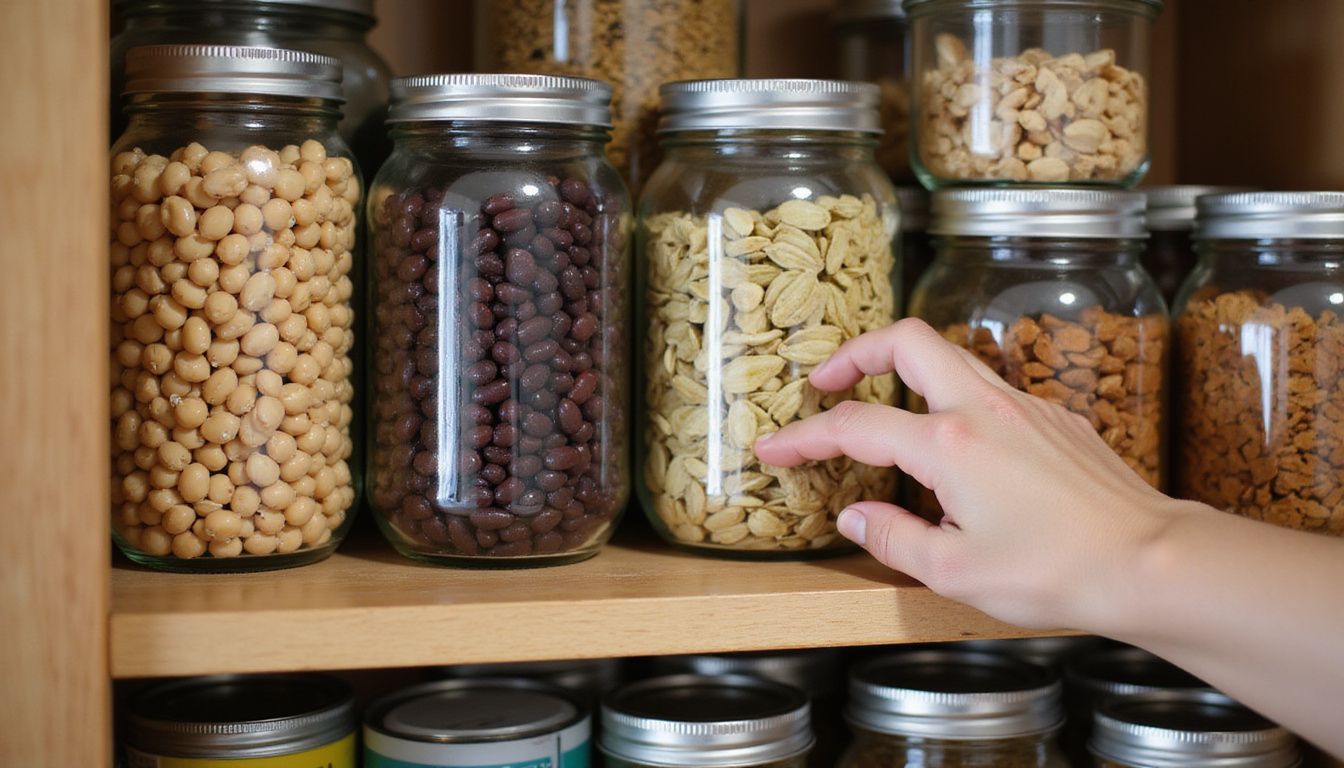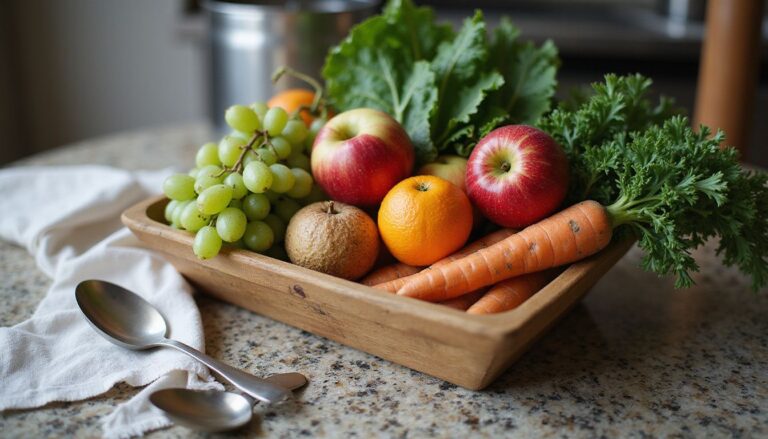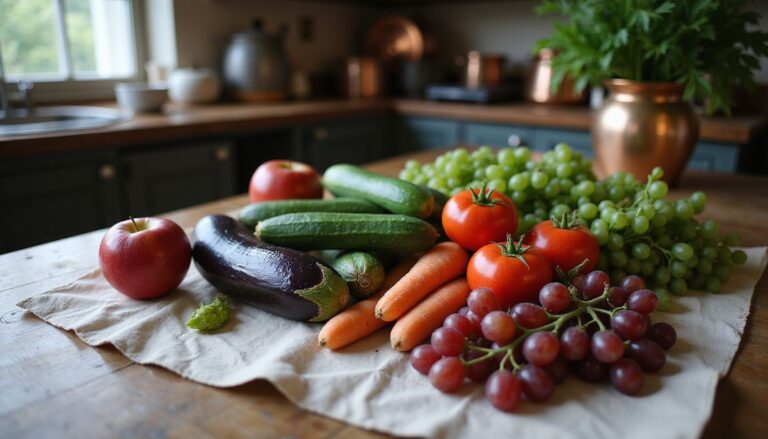Nutrition Meal Plan: Healthy Eating Made Easy With MyPlate And USDA Guidelines
Our Nutrition Assistant AI Suite will transform your body. You will lose fat, get toned, and build muscle. Gain confidence and optimal health.
Planning healthy meals can feel confusing. You want a simple meal plan that fits your day, supports energy, and protects your health. Tools like MyPlate and the USDA Dietary Guidelines give you a clear path for healthy eating.
In this guide, you will learn how to build balanced plates, shop with purpose, and size portions right. You will also get ideas to reduce food waste, stretch time and money, and turn leftovers into new meals. Small shifts in your eating pattern can add up to big health gains.
Key Takeaways
- MyPlate and the USDA 2020-2025 Guidelines steer you to balanced plates with fruits, vegetables, whole grains, lean proteins, and low-fat dairy, which lowers the risk of chronic disease.
- Simple meal planning can cut grocery costs by about 20 percent and reduce food waste, supported by CDC data from 2023.
- Filling half your plate with fruits and vegetables boosts energy, supports healthy weight, and reduces sugar cravings, according to Harvard Health.
- Choosing whole grains instead of refined grains is linked to lower type 2 diabetes risk, as noted by the American Diabetes Association.
- Tracking portions with apps like Start Simple with MyPlate helps you meet calorie needs based on age, sex, weight, and activity level.
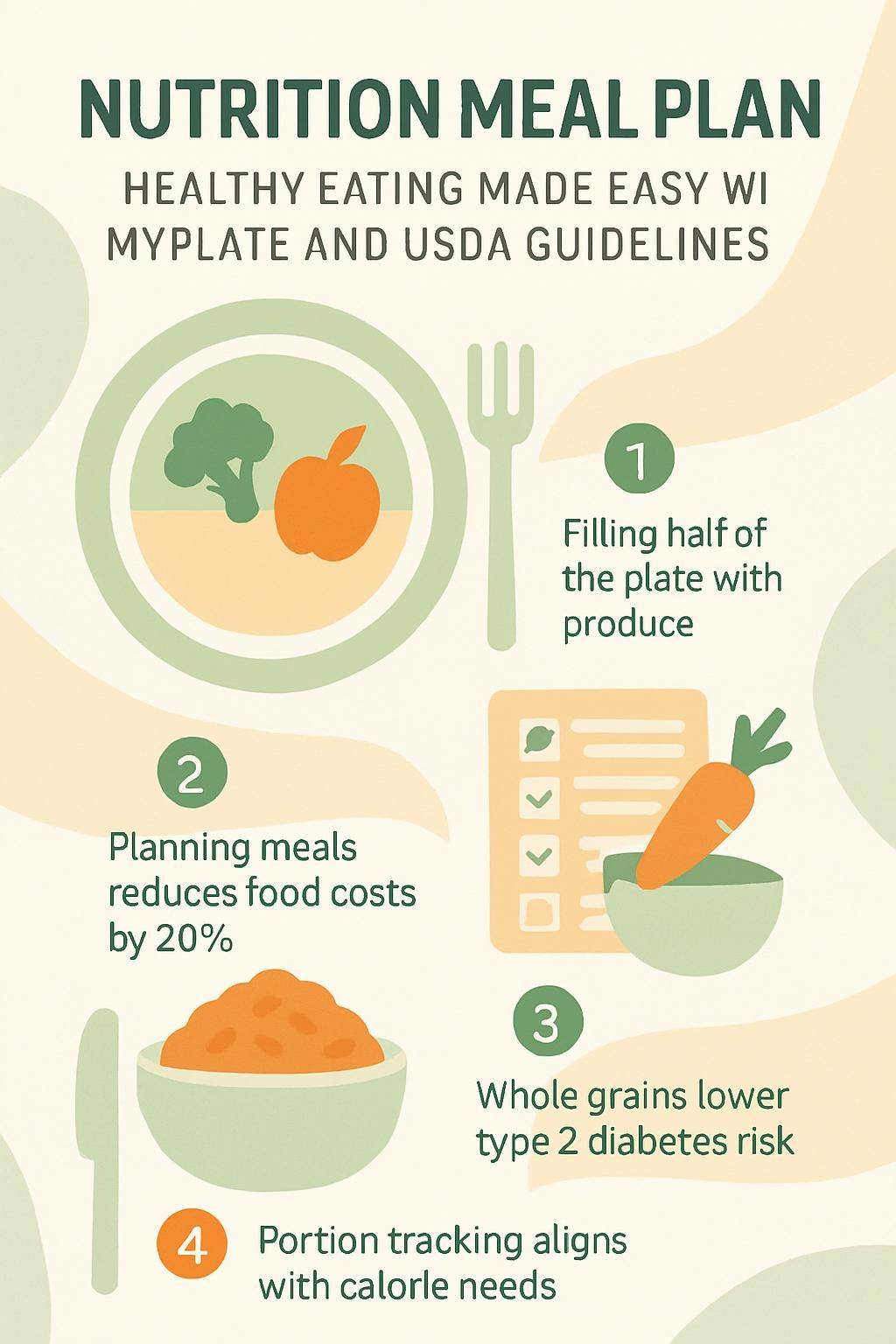
Why Is a Balanced Nutrition Meal Plan Important?
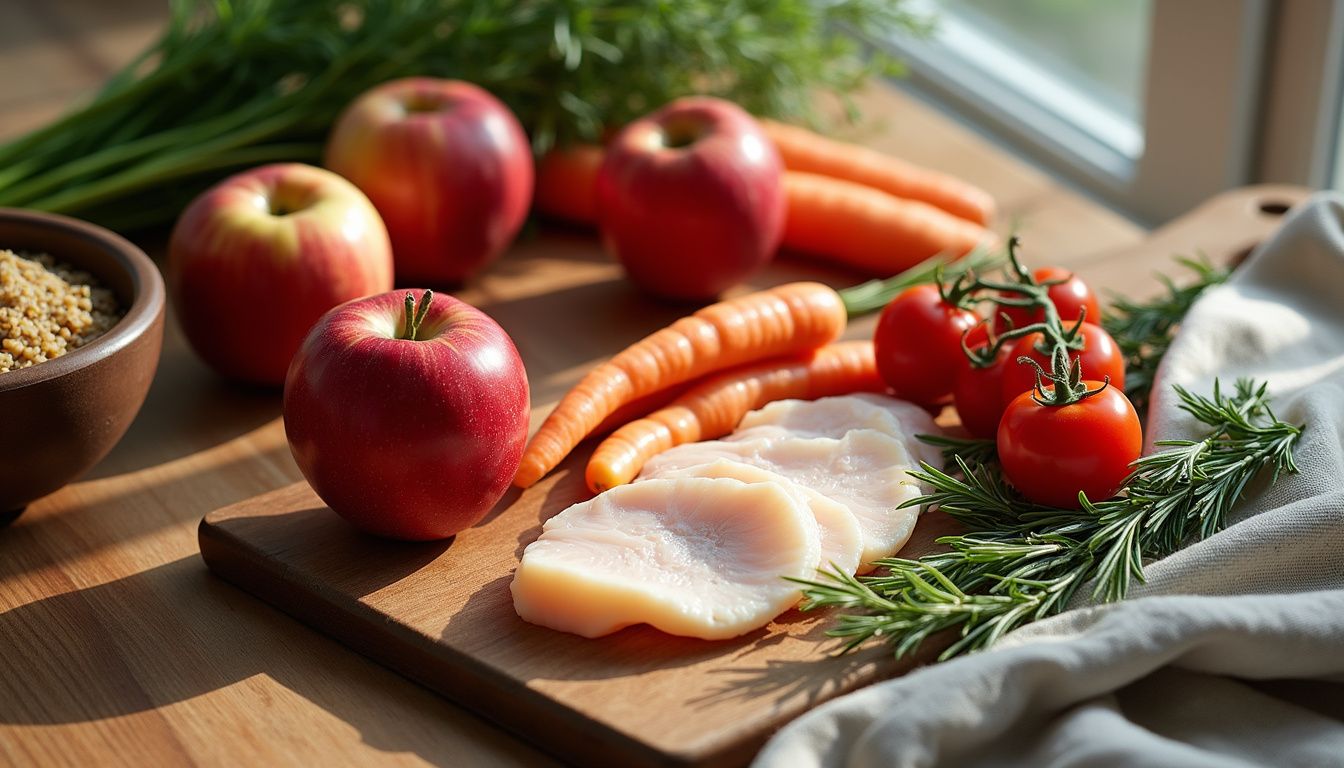
A balanced nutrition meal plan helps you eat from all food groups. You get whole grains, lean protein, fruits, vegetables, and dairy or fortified alternatives in the right mix. This structure makes it easier to measure nutrient intake and follow healthy eating guidance.
What Are the Benefits of Meal Planning?
Meal planning helps you include all five food groups each day. Writing down meals, snacks, and beverages keeps you close to the suggested serving sizes. It also makes it easier to spot gaps or unplanned extras.
Digital tools such as the MyPlate Plan Calculator guide choices that follow the USDA Dietary Guidelines for Americans. These tools show you how many servings from each food group you need based on your calorie target.
Planning ahead lowers food waste and saves time and money. You shop with a list, check dates before you buy, and turn leftovers into new meals. When I started a simple weekly plan, my grocery costs dropped about 20 percent from fewer impulse buys and less spoiled produce.
How Do Balanced Meals Affect Overall Health?
Balanced meals support heart health, steady energy, and a healthy weight. Emphasize fruits and vegetables, whole grains like brown rice and whole-wheat pasta, and lean protein from seafood, poultry, beans, or soy. This approach helps manage calories while delivering essential vitamins and minerals.
People who follow these standards tend to face lower risks of cardiovascular disease and type 2 diabetes. Including low-fat dairy or fortified dairy alternatives maintains bone health while limiting saturated fat. This mix also keeps blood sugar more stable and can reduce cravings for sweetened drinks.
My family noticed calmer moods and better energy after shifting from a typical Western pattern diet high in sodium and saturated fat to MyPlate-style meals focused on salad greens and grilled poultry.
A healthy diet based on balanced meals provides the building blocks for long-term well-being.
Swapping soda for water helps manage calories and supports hydration. Keeping portions in check with tools like printable shopping lists and measuring cups can support healthy body weight, a trend also noted in CDC reports from 2023.
Understanding MyPlate and USDA Guidelines
Understanding MyPlate and the USDA guidelines helps you choose nutrient-dense foods. These tools translate science into clear daily actions that fit your age, size, and activity level.
What Is MyPlate?
MyPlate, created by the United States Department of Agriculture in 2011, organizes meals into five food groups: fruits, vegetables, grains, protein, and dairy. The visual plate reminds you to fill half your plate with fruits and vegetables at most meals.
This approach fits many eating styles. For plant-forward meals, replace animal protein with beans, lentils, tofu, or tempeh. You can adjust portions to match your age, goals, and activity level. A teenage athlete usually needs more calories than someone trying to lose weight.
Tools like the MyPlate Plan Calculator estimate your daily calorie target and suggest food group amounts. During college, following this plan gave me structure without raising costs. It turned quick toast breakfasts and late-night snacks into more balanced choices.
What Are the Key USDA Dietary Guidelines?
The USDA 2020-2025 Dietary Guidelines focus on healthy patterns over your lifetime. Key points include:
- Make half your plate fruits and vegetables.
- Choose whole grains for at least half of your grain servings.
- Pick lean proteins such as poultry, fish, beans, and soy products.
- Use fat-free or low-fat dairy or fortified alternatives.
- Cook with vegetable oils instead of butter or shortening.
- Keep added sugars under 10 percent of daily calories.
- Limit sodium to less than 2,300 milligrams per day.
- Avoid foods with trans fat.
- Drink water instead of sugar-sweetened beverages.
Needs vary by age and activity, but most people benefit from nutrient-dense foods that deliver more nutrition for fewer calories. MyPlate is a simple way to apply these guidelines at the table.
Key Components of a Healthy Meal Plan
A healthy meal plan uses the MyPlate model to guide each meal. Focus on the core building blocks below to improve nutrition and support health goals.
Why Are Fruits and Vegetables Essential?
Fruits and vegetables deliver vitamins, minerals, and fiber that support growth, immunity, and digestion. The plate method suggests filling half your plate with colorful produce because these foods pack the most nutrients per calorie.
Spinach adds iron, citrus brings vitamin C, and bright produce offers antioxidants that protect your cells. Choosing many colors helps you cover different nutrients through the week. Farmers markets and community programs can make fresh produce more affordable.
When I added vegetables to each meal, like peppers on toast or fruit between meals, I noticed better energy and fewer afternoon crashes.
How to Include Whole Grains Daily?
Whole grains contain all parts of the grain, so they offer more fiber, vitamins, and minerals. Aim to include them at most meals.
- Pick brown rice or quinoa instead of white rice.
- Choose whole grain toast at breakfast or whole wheat bread for sandwiches.
- Batch-cook barley, farro, or millet on weekends for quick sides.
- Try steel-cut oats for a hearty breakfast or snack.
Research from the American Diabetes Association links whole grains to lower type 2 diabetes risk and better heart health[1]. Grilled vegetables over farro or barley add fiber and flavor without extra work.
[1] American Diabetes Association. Whole Grains and Type 2 Diabetes: Evidence-Based Benefits.
www.diabetes.org/nutrition.
What Are Good Sources of Lean Protein?
Lean protein supports muscles, hormones, and a strong immune system. Solid options include skinless poultry, fish like salmon or tuna, and lean cuts of beef or pork. Plant proteins work well too. Beans, lentils, tofu, and tempeh provide protein plus fiber.
Last week, I packed a chickpea salad with spinach for lunch and served fish with roasted vegetables for dinner. On busy mornings, I used chia pudding with peanut butter and berries for a quick protein boost.
The USDA encourages variety across protein foods and lighter cooking methods. Grilling, baking, or air-frying keeps added fat lower and flavor high.
What Are Dairy Alternatives and Low-Fat Options?
Smart dairy choices help you reduce saturated fat while getting calcium and protein. Try skim milk, 1 percent milk, Greek yogurt, or part-skim mozzarella.
If you prefer dairy alternatives, fortified soy milk is most similar in protein to cow’s milk, about 7 grams per cup. Almond and oat milks can fit your plan, but many have less protein unless fortified. Check the Nutrition Facts label for protein, calcium, and vitamin D.
Swapping regular cheese for part-skim mozzarella made pizza night at my house lighter without losing taste.
How Do Healthy Fats and Oils Fit In?
Healthy fats help your body absorb vitamins A, D, E, and K. Nuts, seeds, and certain oils support heart and brain health when used in small amounts.
- Use olive or canola oil instead of solid fats.
- Add walnuts, sunflower seeds, or chia seeds to salads or yogurt.
- Keep portions in mind. One tablespoon of olive oil has about 120 calories.
These choices align with MyPlate and make meals satisfying without adding excess saturated fat.
What Are the Benefits of Following a Nutrition Meal Plan?
A nutrition meal plan helps you cover daily needs for vitamins and minerals. It also builds better habits that last, one plate at a time.
How Does It Enhance Nutrient Intake?
Making half your plate fruits and vegetables increases vitamins, minerals, and fiber. Berries bring vitamin C and antioxidants. Nuts offer healthy fats. Broccoli supplies folate and fiber.
Using the MyPlate pattern, you include every food group in steady amounts. That consistency closes nutrient gaps. Sample plans can help you rotate berries at breakfast, leafy greens at lunch, and nuts or seeds as snacks.
Can It Help with Weight Management?
Portion control is a major driver of healthy weight. Many restaurant meals reach 1,500 calories or more. A home meal built with MyPlate can land near 600 to 800 calories and still feel satisfying.
Balanced meals with lean protein and fiber keep you fuller longer. I replaced takeout lunches with simple planned meals and lost eight pounds in three months. Cutting portions and limiting hidden sugars made the difference.
How Does It Boost Energy Levels?
Steady fuel comes from balanced meals spaced through the day. Oatmeal with fruit releases energy slowly and helps prevent mid-morning slumps. Greek yogurt with fruit or small energy bites can bridge long gaps between meals.
Harvard Health notes that regular, balanced meals can reduce fatigue more than a few large ones. Combining vegetables, lean protein, and low-fat dairy supports recovery after busy days and helps you focus at work or school.
Does It Lower the Risk of Chronic Diseases?
Following MyPlate and the USDA guidelines can reduce the risk of heart disease and type 2 diabetes. The pattern favors fruits, vegetables, whole grains, lean proteins, and low-fat dairy while limiting added sugar, saturated fat, and sodium.
Swapping refined grains for whole grains supports steady blood sugar and long-term heart health. Making these choices daily builds protection over time.
How to Design Your Nutrition Meal Plan
You can design a plan that fits your life, tastes, and budget. Start small, then adjust as you learn what works.
How to Evaluate Your Dietary Needs?
Estimate your daily calorie needs based on your age, sex, weight, height, and activity level. A moderately active teen may need around 2,200 calories. An adult woman with low activity might need closer to 1,600.
Track your meals for one week. Compare that log to the USDA guidelines to see where you meet or miss targets for protein, fiber, and other nutrients. Read Nutrition Facts labels to compare sugars, saturated fat, and sodium between products.
Adjust your plan if your log shows too much added sugar or not enough dairy alternatives. I learned I was low on calcium, so I added unsweetened soy milk at breakfast and saw better balance in my weekly totals.
How to Set Realistic Nutrition Goals?
Set goals that match your daily routine. Write a weekly meal plan and use an app to track progress. If you want to lower added sugars or sodium, set a specific daily limit based on the USDA guidelines.
Focus on one change at a time. Increase vegetables by one serving per meal, or swap a few meat-based dinners for plant protein. Check in each week, then add the next step when the first habit feels easy.
How to Add Variety to Your Meals?
Variety improves nutrient coverage and keeps meals interesting. Rotate eating styles, such as Mediterranean, higher-protein, or anti-inflammatory patterns, while still aligning with MyPlate.
Use seasonal produce to save money and boost flavor. Kale often costs less in winter, while berries shine in summer. Try chickpea salads, roasted vegetable bowls, and green smoothies for quick variety.
When I added quinoa bowls and veggie stir-fries to my routine, shopping felt easier and my energy improved.
How to Control Portion Sizes Effectively?
Portion size is the amount you eat. Serving size is the amount on the label. A 2022 review in Advances in Nutrition found that larger portions lead people to eat more without noticing.
A steakhouse dinner might top 1,500 calories. A balanced home version with vegetables and whole grains can be closer to 700 calories. Use smaller plates, measure servings, and pause to check hunger cues.
Understanding the difference between portion and serving size helps you manage calories and stay on track with your plan.
What Tools and Resources Make Meal Planning Easier?
Good tools save time and guide better choices. They help you follow MyPlate and the USDA in everyday meals.
How to Use the MyPlate Plan Calculator?
On MyPlate.gov, enter your age, sex, height, weight, and activity level. The tool estimates your daily calorie target and converts it into food group goals.
For example, a moderately active 14-year-old female around 120 pounds may see goals such as 2 cups of fruit, 2.5 cups of vegetables, 6 ounces of grains, 5 ounces of protein foods, and 3 cups of dairy. This turns nutrition science into a personal checklist.
How to Get Started with the MyPlate App?
Download the free Start Simple with MyPlate app. Add your profile to personalize goals that match the USDA guidelines. Track fruits, vegetables, grains, protein foods, and dairy as you eat.
Set reminders for key habits. Explore recipes, add meals right after eating, and use quick voice tips with Amazon Alexa if helpful. Logging after each meal took me less than a minute and kept my portions in line during busy weeks.
What USDA Meal Planning Tools Are Available?
USDA resources make smart choices easier. FoodData Central lists calories, nutrients, and serving sizes for thousands of foods. MyPlate.gov offers the Plan Calculator, tips, and budget-friendly ideas that link with local grocery savings.
Use the Dietary Guidelines for Americans 2020-2025 for deeper science-based advice across life stages. During a busy semester, these tools helped me choose balanced options faster and stay consistent.
What Does a Sample Healthy Meal Plan Look Like?
Seeing examples turns ideas into action. Use these simple options as building blocks, then tailor to your taste and budget.
What Are Healthy Breakfast Options with Whole Grains and Fruits?
Try a blueberry and peanut butter chia pudding for protein and fiber. Mix chia seeds with milk or soy milk, stir in berries and peanut butter, then refrigerate overnight.
For Day 2, toast whole grain bread and top with eggs or egg substitute. Add red pepper flakes, cilantro, and lime for flavor without extra calories. On Day 3, sauté spinach, mushrooms, peppers, and broccoli. Add a light sprinkle of cheddar for more protein if you like.
These breakfasts follow MyPlate, combining whole grains, fruit, and protein to keep you full through the morning.
What Are Nutrient-Dense Lunch Choices?
Build salads with lean protein. Day 1 might be grilled chicken over greens with strawberries, tomatoes, feta, and honey Dijon vinaigrette. For plant-forward days, try a chickpea salad or a roasted vegetable bowl for fiber and antioxidants.
Whole grains bring minerals and longer-lasting energy. Make a kale and quinoa bowl or a whole grain sandwich with mozzarella and basil. A light Greek yogurt dressing adds calcium and probiotics for gut health.
I swapped my usual fast-food lunch for these ideas during finals week and noticed better focus all afternoon.
What Are Balanced Dinner Selections with Protein and Vegetables?
Day 1, grill fish with onions and zucchini in about 25 minutes. Serve with brown rice or quinoa to add whole grains. This mix delivers high-quality protein and fiber-rich vegetables.
Day 2, roast chicken breast with colorful vegetables, then glaze with a light honey-soy sauce. Day 3, spice it up with chipotle chili powder and prepared salsa. Sheet-pan dinners simplify cleanup and make it easier to stay consistent on busy nights.
What Are Healthy Snack Ideas with Controlled Portions?
Yogurt parfaits are quick and balanced. Use plain low-fat Greek yogurt with berries or sliced fruit. A half-cup of yogurt with a quarter cup of blueberries stays under 150 calories and adds protein and calcium.
Roll oats, peanut butter, and a bit of honey into small energy bites. Blend green smoothies with baby spinach, banana, and unsweetened almond milk in single cups. For savory options, make lettuce wraps with diced grilled chicken. Keep each wrap to about three ounces of chicken.
High-protein snacks like a hard-boiled egg or a slice of reduced-fat cheese can curb hunger. I carry snack-size bags with eight almonds or twelve baby carrots to avoid overeating on busy days.
How to Maintain Your Nutrition Meal Plan Successfully
Consistency comes from routines that save time and cut stress. A little planning goes a long way during the week.
How to Plan Ahead for Grocery Shopping?
Start with a grocery list based on your weekly plan. Cross off items you already own to avoid duplicates. MyPlate offers ready-made lists for sample plans, including a one-week Mediterranean dinner list on a budget.
Last month, I used a MyPlate checklist. It helped me stick to my budget and cover all food groups, including whole grains, lean protein, dairy alternatives, fruits, and vegetables.
Preparing meals in advance makes it even easier to follow through.
What Are Tips for Preparing Meals in Advance?
Batch-cook staples on weekends. Roast vegetables, cook beans, and prepare brown rice so you can assemble lunches or dinners fast. Store meal-sized portions in airtight containers for freshness.
Plan to cook once and eat twice. Extra baked chicken becomes salad or wrap fillings later in the week. I roast a tray of sweet potatoes and wash leafy greens in advance to cut cooking time after work.
How to Use Leftovers Optimally?
Store leftovers in airtight containers right after meals and label them with the date. Plan to reuse them within 3 to 4 days. Build your next meals around what you have on hand.
Roasted vegetables make easy lunch bowls or wraps. Grilled chicken can pair with brown rice for a fast stir-fry. The USDA estimates Americans waste about 30 percent of the food supply each year. Using leftovers supports your budget and reduces waste.
I often cook extra quinoa for dinner and turn it into breakfast bowls or nutrient-dense lunches the next day.
How to Adjust Meal Planning for Busy Schedules?
Pick dinners that cook in 25 minutes or less. No-cook meals and 5-ingredient plans save even more time. Batch-cook grains, chop vegetables ahead, and portion snacks for grab-and-go convenience.
Use the MyPlate app to manage lists and track food groups. Planning in advance leads to better choices even during hectic weeks, a trend also reflected in USDA research.
How to Overcome Common Meal Planning Challenges?
Meal planning can feel tough at first. A few simple strategies help you stay on track without extra stress.
How to Plan Healthy Meals on a Budget?
Use MyPlate’s budget-friendly plans. Try weekly higher-protein dinners for about $80, no-cook plans around $100, or 5-ingredient dinners near $90. Build meals around affordable staples such as beans, eggs, oats, frozen vegetables, and seasonal produce.
Check local store deals or digital coupons featured in MyPlate resources. Batch cook simple recipes at home to avoid costly takeout later in the week.
How to Manage Time for Meal Preparation?
Choose sheet-pan dinners with plenty of protein and fiber. These recipes reduce prep and clean-up since they cook on a single pan. Look for 500-calorie meals that take three steps or fewer.
Set a weekly prep window, such as Sunday afternoon. Use MyPlate templates to write your menu and portion grains, proteins, and vegetables into containers. You will have grab-and-go meals that keep you aligned with the USDA guidelines.
How to Accommodate Dietary Restrictions?
Different needs call for smart swaps. The USDA and MyPlate include guidance for dairy alternatives like fortified soy milk and almond beverages. If you need gluten-free options or have a medical procedure coming up, read labels and pick simple foods with short ingredient lists.
When I helped a friend with celiac disease, planning ahead and using apps with certified gluten-free items made shopping easier. For plant-focused meals, replace animal protein with beans, tofu, or tempeh while keeping balanced macronutrients.
Why Is Physical Activity Important for a Balanced Lifestyle?
Nutrition and movement work best together. Regular activity helps your body use fuel well and supports mood and focus.
How to Combine Nutrition and Exercise?
Match your meals to your training. Eat more complex carbohydrates, such as whole grains, before workouts for energy. Have lean protein afterward to support muscle repair. If you train for endurance, raise your whole grain intake on heavy days.
When I prepared for a 10K, yogurt with berries gave quick protein and carbs. Brown rice added steady fuel without slowing me down. Recovery felt easier and progress came faster.
What Are the Benefits of Regular Physical Activity?
Regular activity supports a healthy weight, stronger muscles and bones, and a healthier heart. Many experts recommend at least 150 minutes of moderate exercise each week for most adults, which aligns with dietary guidance.
People who meet activity goals can lower their risk of heart disease by around 30 percent. Evening walks helped me build stamina and made it easier to stick with my nutrition meal plan.
Conclusion
Healthy eating gets easier with MyPlate and the USDA guidelines. Build meals that fill half the plate with fruits and vegetables, choose whole grains, and use lean protein and low-fat dairy or fortified alternatives. These habits improve nutrient intake, support energy, and help manage weight.
Use simple tools, such as the MyPlate app and the Plan Calculator, to set targets and measure progress. Plan shopping lists, control portions, and reuse leftovers to save time and money. Small, steady changes add up to lasting results.
This article is for general education. For personal advice, talk with a registered dietitian or your healthcare provider.
FAQs
1. What is the MyPlate method and how does it help with healthy eating?
The MyPlate method, developed by the United States Department of Agriculture, uses a plate graphic to show ideal food group portions for each meal. It helps people balance fruits, vegetables, grains, protein foods like chicken or beans, and dairy such as milk or yogurt. This approach makes it easier to plan meals that meet USDA nutrition guidelines.
2. How do USDA guidelines support making a nutrition meal plan?
USDA guidelines provide science-based advice on what and how much to eat from each food group daily. They recommend limiting added sugars and sodium while increasing intake of whole grains and leafy greens. Following these rules can improve heart health and reduce risk for chronic diseases according to studies published in peer-reviewed journals.
3. Can you give an example of using MyPlate in everyday life?
Last year I started planning my lunches using the MyPlate model after reading about its benefits in a government report. For one week I filled half my lunchbox with raw carrots and apple slices; one quarter had brown rice; another quarter held grilled turkey breast; plus low-fat yogurt on the side. This simple change helped me feel more energetic during work hours.
4. What are some key statistics related to following USDA dietary recommendations?
Research shows only 10 percent of Americans eat enough vegetables daily while most consume too many refined grains according to National Health data (CDC). People who follow USDA guidance have lower rates of obesity compared with those who do not meet recommended servings per day.
Summary: The MyPlate method offers clear visual cues for balanced meals based on credible research from the United States Department of Agriculture’s dietary standards. Using this tool along with official guidelines supports better choices at every meal which can lead to improved long-term health outcomes as shown by national surveys and scientific reviews.

